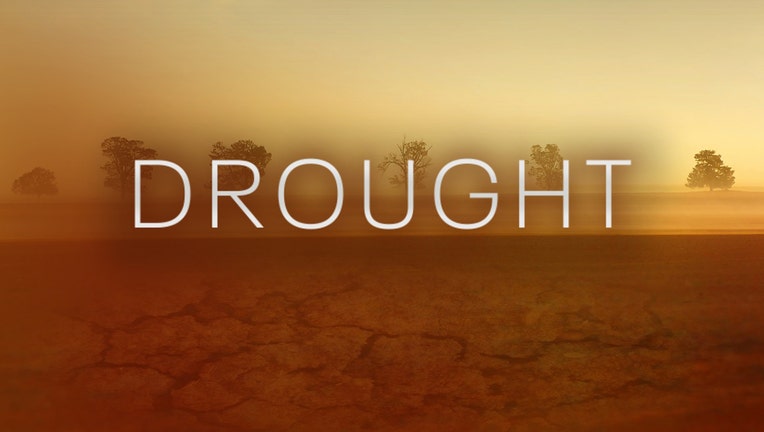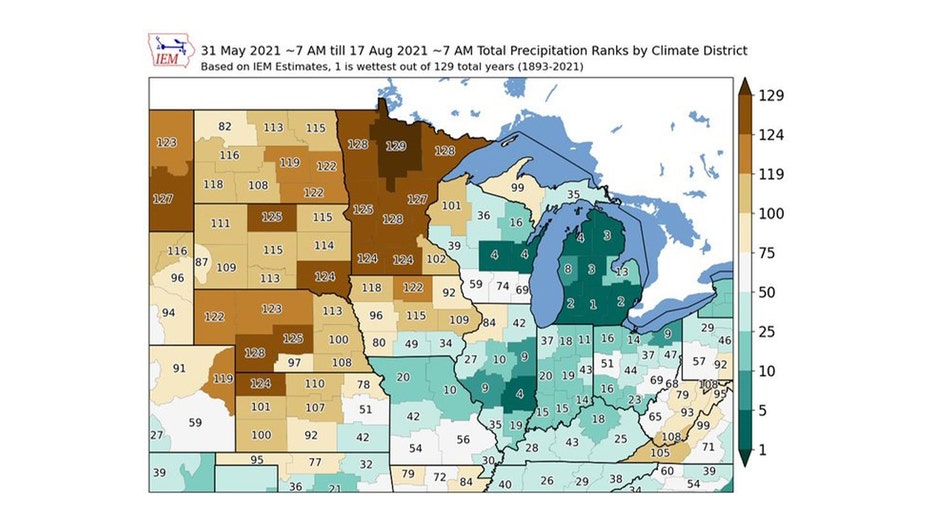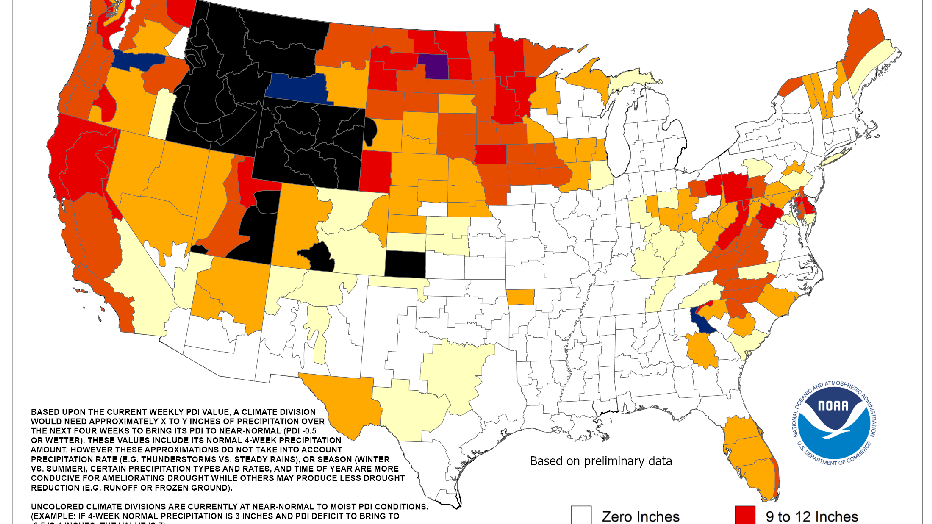Minnesota drought: Your questions answered

(FOX 9) - For the first time in several years, we have had a drier than average summer. Since 2014, we've had some very wet summers, receiving copious amounts of rain often leading to flooding and some occasional severe weather. But, this year has clearly been different. Rainfall has been sporadic at best. Since June 1, much of Minnesota has received less than half the average rainfall for the period. Nearly half the state, including parts of the Twin Cities, have totaled even less, recording less than a quarter of the "typical" summer rains. This has led to widespread drought conditions with a severe to exceptional drought appearing in just about every spot statewide.
That is the most simplistic definition of a drought; a period of unusually dry weather that is persistent enough to cause water supply issues.
That supply starts with our top soil, the 4 feet of soil that is directly underneath our feet. This is where the bulk of our rainfall ends up and then gets used by most of our vegetation. Once this area begins to dry, there is less water running off into area lakes, rivers, and streams. That's when these waterways start to fall which can be some of the first visible signs of a water shortage. If rain doesn't show up at this point, then the topsoil dries out entirely and now the big problems begin. Grasses will begin to die, turning brown and crispy. Crops will stop producing their yields, leading to fewer ears of corn for example. Trees will become stressed and can actually go dormant to try and survive until next year.

Drought causes some Minnesota farmers to harvest early
The entire western portion of Minnesota is currently experiencing a extreme or severe drought, in the middle of what has been a very dry summer. Since less than 2% of the state’s farm land is irrigated, farmers who are very reliant on Mother Nature, have been let down.
And then of course there's the water that we use for drinking, laundry, cooking and other everyday household uses. With both surface and ground water drying up, we start to use the excess well water that our pipes are attached to. While this is a great and often abundant source, using more of it during a drought can take years or even decades to replenish. Once that water is gone, then your faucets dry up and suddenly we don't even have enough water to drink. Now, that's obviously worst-case scenario that would take years of drought to produce, but it's always a possibility because once a drought begins, it can be very difficult to get enough moisture for it to end. This is the main reason why cities implement water restrictions during a drought because overuse can certainly lead to long term water supply issues.

St. Paul Regional Water Services imposes restrictions as state enters next drought phase
St. Paul Regional Water Services, which services St. Paul and several suburbs, is imposing watering restrictions amid ongoing drought conditions, including watering schedules and restrictions on when residents can water.
That is an overview of what it means to be in a drought, but now I want to hear from you. This will be an open thread, updated daily, with your questions about the drought. You can read the questions that have already been answered below. Have more questions? Email us at fox9news@fox.com, tweet us using #FOX9Weather or send a direct message to via Twitter, Facebook or Instagram and the FOX 9 Weather Team will answer it.
Be sure to download the FOX 9 Weather app to stay up to date on the latest weather and drought-related news, as well as forecasts to see when we'll get rain next. Download it for Android or Apple.
What is the current state of our drought?
The easiest, shortest, and most concise way to show you the state of our drought, other than just showing pictures of dried up creeks and a VERY low Mississippi River, is with the image below.

This shows the total precipitation rank for the amount of rainfall the Upper Midwest has seen since June 1. It breaks each state into 9 fairly equal sized districts and gives them a number. The number represents the district’s rank of rainfall based on the 129 years of reliable records. The higher the number, the drier the time frame when compared to average. For example, north central MN is shaded dark brown with the number 129. That means, in the last 129 years, this is the driest summer on record for north central Minnesota from June 1 until Aug. 17. Also notice that every other district, other than southeastern Minnesota, is in the top 5 driest since June 1. That is very telling and shows just how dry the last 10 weeks or so have been. On the opposite side of the coin, much of Lower Michigan has experienced one the wettest summers on record.
How much rain do we need to end the drought?
To end a drought. you have to exceed your average amount of rainfall. And in the cases of extreme drought, you have to exceed the average amount by a lot.
So, even getting average rains right now won't put a dent in the drought. It will prevent it from getting worse, but we will still have a rainfall deficit. Through the summer, we average roughly an inch of rain per week. That means, to make up for any lost ground, we have to get more than an inch of rain per week.

(FOX 9)
Right now, we have been getting significantly less than that, which is why our drought continues to get worse. The National Oceanic and Atmospheric Administration, or NOAA, breaks down the state and country into similar sized regions. For much of the central and northern MN regions, we would need "-12 inches of rain over a four-week period to end the drought. Southern and western areas would need slightly less. To put that into perspective, that would be roughly triple the average precipitation for a summer month and has never been done before in a months' time for many areas. So, you have to assume it will take much longer than a month to escape the drought.
Why doesn't a drought go away when it rains?
An individual storm will not squelch the drought, especially one of this magnitude. Drought is a long-term process that takes many weeks or months to both get into and out of.
Drought is all about water supply, both above ground and below ground. Soil moisture takes time to replenish because not everything that falls during a storm will be able to soak into the ground. Some of it runs off. But, this is also necessary to replenish the water in our lakes, streams and rivers. One storm cannot replenish the ground water as well as the surface water that quickly. Even if we get an epic rainstorm.
Let's say that your house hypothetically gets a massive storm that dumps 6 inches of rain in just two hours. Would that end the drought? Nope. Most of that rain would run off because the soil can only soak in so much water so quickly. That runoff then heads for nearby lakes, creeks and rivers. Does that replenish the waterways? Yes, but likely not nearly enough to return them to average levels because they were so low to begin with.
Not to mention, in this hypothetical scenario, if your house received 6 inches of rain, it's doubtful the rest of the area got that much. The rest of the area likely received far less, which means the river system would only see a minor to moderate jump in water levels. Every single square inch of land would need to get that 6 inches rainfall to see significant improvement, which is just not practical.
To get significant improvement in a drought, you need a persistent wet pattern over several weeks and/or months that build up soil moisture and surface moisture over time.
How does the drought rank in Minnesota history?
The drought monitor we know today hasn't been around that long, only since the turn of the 21st century. But since then, this is the first time the most severe drought category, called exceptional, has appeared in the state.
Comparing this summer's statewide precipitation though to other summers over the last 150 years, this ranks as one of the worst. But, that statement does come with a caveat. While this will be one of the hottest and driest summers on record, it can be tough to compare this drought to others in years past, especially since it's not over yet.
The severity of a drought is often times in the eye of the beholder because it impacts everyone differently. Every drought has different intensities at different times of the year and lasts a different length of time. So is a drought that lasts six months but is more intense actually worse than a drought that last two years but is less intense? Not sure there's an answer to that. What we can say for sure though is that this has been the driest summer statewide since 1988.
Does a shortage of rain mean a drought will occur?
Yes, that is generally the definition of a drought. Below average moisture for an extended period of time leading to a water shortage.
However, there are plenty of other factors that can play a role in how intense or lengthy a drought can be. For example, our drought began and expanded very quickly this year because it was simultaneously very warm. If we had a similarly dry period in the fall, like October and November when temperatures are much cooler, then our drought would not be nearly as significant.
The same can be said for length. There can be short term droughts that last only a few months, but there can also be long term droughts that last years, or even decades. Parts of the West Coast have been experiencing a long-term drought over the last 20 years or so. It waxes and wanes through the years, but has been a significant factor for the last couple of decades. Unfortunately, there is no way to know for sure when a drought will end.
How often do droughts occur?
Droughts are a naturally occurring part of weather on this planet. Every location across the globe will be in a drought at one time or another. It stems from year to year, decade to decade, and millennium to millennium cycles in our atmosphere. This means droughts can occur at just about any time and any location. Suddenly the overall weather pattern can change and it just stops raining on a regular basis.
However, the events over the last half century or so have shown that some areas are more prone to droughts than others. Here in Minnesota, our average annual precipitation is actually increasing. We have seen roughly a 2-inch rise in yearly moisture in the last 30 years or so, now averaging a little over 30 inches of liquid moisture a year in the Twin Cities. Therefore, droughts have become less common in Minnesota.
For other parts of the country, however, drought has become a way of life. The West appears to be getting drier on average with drought encompassing some part of the west on an almost constant basis.
What should I do during a drought?
The one thing that the average person can do to have the greatest impact on the drought is cut back on overall water usage.
It's not something many of us think about on a daily basis. In the grand scheme of things, water is extremely abundant and fairly cheap. But during a water shortage, the last thing you want to do is waste it. So, cut back on wastefulness. DO NOT water your plants, flowers, or trees during the day. Get a timer from your local garden shop, hook it up to your faucet, and set it to run after the sun goes down. This will prevent excess evaporation.
Also try taking shorter showers, using few dishes and washing bigger loads of clothing. In most cases, you don't have to change your daily life or make huge adjustments. But, little changes to conserve where possible can have huge impacts on our water supply over a long period of time.
How will the drought effect the fall?
The biggest thing you'll likely notice is the lack of fall colors. Trees don't produce brilliant fall colors when they're stressed. Often times, they will go dormant as fast as possible in the fall to conserve stored up energy to bloom in the spring and hope that there will be more moisture around then for them to survive. This quick dormancy often means that trees don't stay active long enough for their leaves to run through the spectrum of colors. So they go from green to brown quite quickly. This isn't necessarily the case with every tree, so there will still be at least some fall color, especially in metro areas where home owners have been watering. But overall, I would expect a pretty dull color season this year.
Other noticeable changes with a significant fall drought are larger temperature swings from morning to afternoon because the dry ground is more efficient at both warming and cooling. Ponds and lakes could actually begin freezing sooner because there is less water in them allowing the water temps to fluctuate more easily. Our fire season will also likely last longer as plants go dormant sooner. This could lead to additional wildfires that are larger and more intense.
Will we still have a drought next year?
Just like any other long term weather pattern, droughts can be next to impossible to predict. This is mostly because it takes large scale and lengthy pattern changes for any improvement to occur. Here in Minnesota though, we have an additional hurdle to tackle that much of the U.S. does not. In the winter, our soil freezes. Once it freezes, moisture can't get in or out until it thaws in the spring. This means that if we are still in a drought by December, any winter precipitation won't help. While significant winter and early spring snow can help replenish ponds, lakes, and rivers, it won't help soil moisture. This means that once we hit winter, the likelihood of getting any substantial improvement in the drought and soil moisture until mid to late spring is almost zero. So if we want to escape this drought before April of next year, then we better pray for a VERY wet fall.

